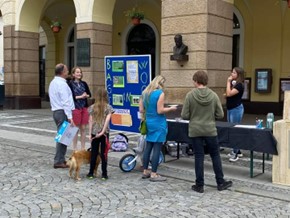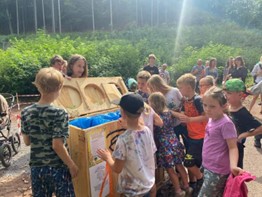Reducing litter in the suburban forest
As part of the project, lower secondary school students decided to respond to the problem of the amount of garbage in nature. Their aim was to reduce the amount of litter in the suburban forest and encourage the local community to clean up. That’s why they decided to make wooden boxes with garbage bags. Every visitor of the forest can take a bag and collect garbage on the walk, which they then put in a designated place.


The main output is several wooden boxes – trash cans, which the students created themselves from the project to the final work with wood. In addition, the students created a bulletin board with information about the project, posters, information leaflets, a photo book about their journey through the project and a promotional article. They also organized an information campaign for the public – they had a stand with leaflets on the square and explained the whole event to passers-by.
A project team worked on the project, and other elementary school students and older children from kindergarten joined in at various stages. They cooperated with the city management (mainly the deputy mayor), the city’s press spokesperson, representatives of the forest administration, experts – carpenters, parents (borrowing tools, participating in a voluntary work, helping to transport mailboxes to the forest) and the whole community (sharing opinions and suggestions regarding the project, participating on the voluntary work, use of waste containers).


The children implemented the program as part of their lessons and in their free time. They used skills and knowledge across subjects to implement the project. Pupils learned more about sustainability, became more aware of local problems, began to perceive their surroundings differently and gained the important experience that they can do something to change around them. Pupils perceive a shift in presentation and dealing with people as very important. They gained first experience in communication with the city management or other “decision-makers” and experts, they also had contact with the general public. For most of them, it was an exit from the comfort zone, they overcame stage fright and gained more self-confidence. Another area where there was a huge learning curve for them was woodworking. They got better at designing and planning, learned how to operate different tools and learned a lot about the woodworking process. The pupils themselves say that thanks to the project they have learned a lot in the field of carpentry, but much more in terms of communication, cooperation, organization of work and implementation of their own activities.
